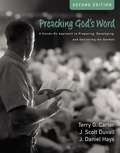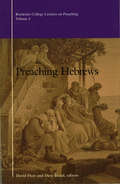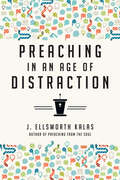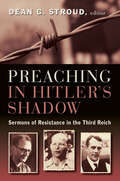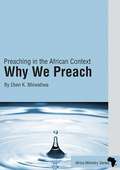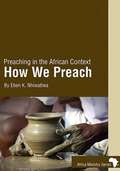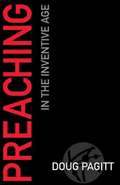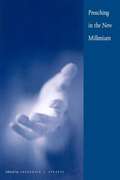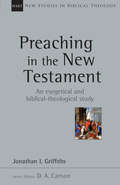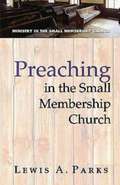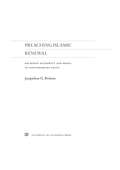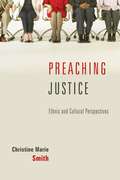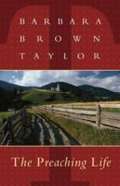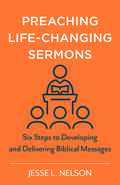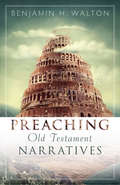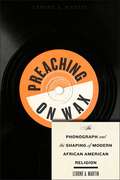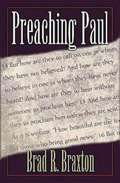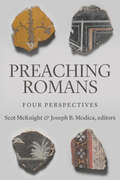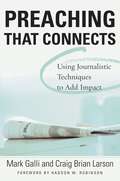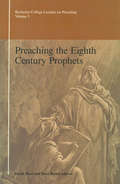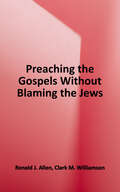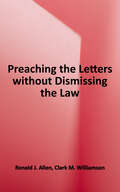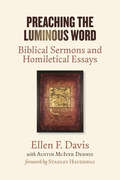- Table View
- List View
Preaching God's Word, Second Edition: A Hands-On Approach to Preparing, Developing, and Delivering the Sermon
by Terry G. Carter J. Scott Duvall J. Daniel HaysPeople in churches today are hungry for a word from God. Preachers need to prepare and deliver sound biblical sermons that connect with their audience in a meaningful way. Whether you are a student who is new to preaching or a veteran looking to brush up your preaching skills, you will benefit from Preaching God's Word.Good preaching begins with good exegesis. The second edition of Preaching God's Word is a user-friendly, practical, and proven textbook that walks you through the five steps of the "Interpretive Journey" from the biblical text to contemporary application:Grasp the text in their town (what it meant to the original audience).Measure the width of the river that separates the biblical context from today.Cross the principle bridge by identifying the timeless theological principles.Consult the biblical map.Grasp the text in our town.While the science of solid biblical interpretation is essential to effective preaching, it must be married to the art of contemporary communication in order to bring the message home. Preaching God's Word also shows you how to understand your audience, develop powerful applications, use illustrations well, and deliver the sermon effectively. The concluding chapters discuss the unique preaching challenges presented by the various biblical genres, providing interpretive keys, things to avoid, and numerous examples.
Preaching Hebrews: Preaching Hebrews (The\rochester College Lectures On Preaching Ser. #4)
by David Fleer Dave BlandThe Rochester College Sermon Seminar and the series of books it has inspired have been built on the conviction that Christian preaching today needs revision. Such reforming begins with a close and faithful reading of Scripture, an engagement so serious that the world of Scripture ultimately sets agendas and invents expectations for meaningful life...In this present volume, too, we wish to grant the book of Hebrews the opportunity to pull all of us into the world it envisions, allowing it the power to judge, convict, and form us into a community God desires. This is not an easy task for several reasons, most notably the fact that the world of Hebrews is quite alien from our own...Like previous volumes in the Rochester Lectures on Preaching, the current work is divided into two parts. The first is a collection of four related essays meant to orient the reader to the world clearly conceived in Hebrews. The second half appropriates this orientation with sermons for particular Christian congregations.- Excerpts from David Fleer's Introduction
Preaching in an Age of Distraction
by J. Ellsworth KalasPreaching's Top Books on Preaching Let your eyes look straight ahead; fix your gaze directly before you. Give careful thought to the paths for your feet and be steadfast in all your ways. ��� Proverbs 4:25-26 Preaching is difficult enough under the best of circumstances. But what are we to do when it seems that all of us���hearers and preachers alike���are constantly distracted? Veteran preacher and homiletics professor J. Ellsworth Kalas offers wise insights for effective preaching in an age of distraction. He examines how people have been distracted in every era and explores how God can meet people precisely at the point of their distraction. Regardless of whatever new technologies come our way, this call to pastoral attentiveness, creativity and excellence provides avenues for connecting with congregations with a countercultural clarity of focus. Rediscover how the proclamation of the Word still speaks profoundly to distracted hearers. Invite your congregation to a renewed attention to the things of God.
Preaching in Hitler's Shadow: Sermons of Resistance in the Third Reich
by Dean G. StroudWhat did German preachers opposed to Hitler say in their Sunday sermons? When the truth of Christ could cost a pastor his life, what words encouraged and challenged him and his congregation? This book answers those questions.Preaching in Hitler's Shadow begins with a fascinating look at Christian life inside the Third Reich, giving readers a real sense of the danger that pastors faced every time they went into the pulpit. Dean Stroud pays special attention to the role that language played in the battle over the German soul, pointing out the use of Christian language in opposition to Nazi rhetoric.The second part of the book presents thirteen well-translated sermons by various select preachers, including Dietrich Bonhoeffer, Karl Barth, Rudolf Bultmann, and others not as well known but no less courageous. A running commentary offers cultural and historical insights, and each sermon is preceded by a short biography of the preacher.
Preaching in Pictures: Using Images for Sermons That Connect (Artistry of Preaching Series)
by Peter JonkerThe preachers' words are meant to connect, to resonate with and influence hearers. Too often, sermons fall short. Preaching in Pictures: Using Images for Sermons that Connect shows how to choose, use, and illustrate a controlling image in every sermon. Readers learn how one effective image can cause the proclaimed word to sink in and transform the listener. Peter Jonker helps readers to build skill and confidence, with practical instruction, examples and straightforward teaching. "Good preaching isn't just the dissemination of information; it is a conduit of Spirit-empowered formation. Such formative preaching doesn't convince the intellect; it captures the imagination. A controlling image has the power to do just this--to capture the imagination. Peter Jonker invites preachers to understand and to effectively use controlling images for formation of the hearer. This great book is erudite and accessible, theoretically grounded and yet intensely practical, complete with exercises. I'll be pointing preachers to it from now on." --James K.A. Smith, author of Desiring the Kingdom: Worship, Worldview, and Cultural Formation "Preaching in Pictures opened eyes of my imagination. I can't wait to write my next sermon." --Heidi DeJonge Pastor, Westside Fellowship Christian Reformed Church, Kingston, Ontario "Peter Jonker offers preachers practical ways to connect the gospel in the hearts of listeners, with a wealth of helpful examples. This is a fresh and welcome perspective, just the book for preachers whose sermons have reached their shelf life and are in need of new energy." --John Michael Rottman, Professor of Preaching Calvin Theological Seminary "Sane, balanced, assured--but also strikingly insightful--Peter Jonker's writing is a sheer gift to anyone interested in eventful preaching. Every page is worth pondering. Jonker writes with great verve and authority." --Cornelius Plantinga, Jr., Author of Reading for Preaching: The Preacher in Conversation with Storytellers, Biographers, Poets, and Journalists
Preaching in the African Context: Why We Preach
by Mwanabute REV Nday BondoThis book is one of two volumes on Preaching in the African Context. For both seasoned preachers and beginners, including students in seminaries, Bible colleges, and universities, this first volume explores Why We Preach and the principles of contextual preaching in Africa. Nhiwatiwa draws on his experience as a pastor and bishop, as well as his research as a lecturer, in demonstrating that contextual preaching serves as the most appropriate way of communicating the gospel in Africa. By tapping into African cultural modes of communication, preachers can engage the minds and touch the hearts of the people in effective ways. Read these volumes to see why contextual preaching is so urgent for meeting the ministry challenge in Africa today and how it can open new horizons for the proclamation of the gospel.
Preaching in the African Context: How We Preach
by Nhiwatiwa Bishop Eben KanukayiThis book is the second of two volumes on Preaching in the African Context. For both seasoned preachers and beginners, including students in seminaries, Bible colleges, and universities, this second volume explores How We Preach and the practice of contextual preaching in Africa. Nhiwatiwa draws on his experience as a pastor and bishop, as well as his research as a lecturer, to offer preachers (and teachers of preachers) step-by-step guidance. The two volumes go hand in hand; preachers need both principles and practice to proclaim the gospel faithfully and effectively in context. Read these volumes to see why contextual preaching is so urgent for meeting the ministry challenge in Africa today and how it can open new horizons for the proclamation of the gospel.
Preaching in the Inventive Age
by Doug PagittWhat kind of communities are we forming? What story are we telling? How can we tell it more effectively? Pagitt takes on these questions and investigates the goals and roles of preaching in the Inventive Age.
Preaching in the New Millennium: Celebrating the Tercentennial of Yale University
by Frederick J. StreetsIn this collection of sermons, fifteen distinguished religious leaders reflect upon the moral, social, and political nature of our time. The sermons originated during the Tercentennial celebrations at Yale University, and they provide a vivid snapshot of the rich religious history of Yale and its contribution to the character of our nation. Some of America's most prominent religious figures are here, among them William Willimon, William Sloane Coffin, Peter Gomes, Gardner Taylor, and Barbara Brown Taylor. Their sermons offer valuable religious and intellectual insights into our national consciousness both before and after the tragedies of September 11, 2001. In a lively introduction to the volume, Rev. Frederick J. Streets sets the collection in context and contemplates the past and present nature of religious life at Yale.
Preaching in the New Testament (New Studies in Biblical Theology #Volume 42)
by Jonathan GriffithsMany Christians share the assumption that preaching the word of God is at the heart of God's plans for the gospel in our age, that it is vital for the church's health, and that it is the central task of the pastor-teacher. Many helpful books on preaching are available. The vast majority are concerned with "how-to," but relatively few focus primarily on the character and theology of preaching according to Scripture. Two key, interrelated questions need to be addressed. First, is there such a thing as "preaching" that is mandated in the post-apostolic context—and, if there is, how is it defined and characterized? Second, how does post-apostolic "preaching" relate to the preaching of the Old Testament prophets and of Jesus and his apostles? In this New Studies in Biblical Theology volume Jonathan Griffiths seeks answers to these questions in the New Testament. In Part One he gives an overview of the theology of the Word of God, surveys Greek terms related to preaching, and looks at teaching concerning the scope and character of other word ministries in the life of the church. In Part Two his exegetical studies concentrate on teaching that relates especially to the post-apostolic context. In Part Three he summarizes the exegetical findings, sets them within the context of biblical theology, and proposes a number of broader theological implications. Griffiths's accessible, scholarly investigation will be of value to scholars, pastors, preachers, and Bible teachers. Addressing key issues in biblical theology, the works comprising New Studies in Biblical Theology are creative attempts to help Christians better understand their Bibles. The NSBT series is edited by D. A. Carson, aiming to simultaneously instruct and to edify, to interact with current scholarship, and to point the way ahead.
Preaching in the Small Membership Church (Small Membership Church)
by Lewis ParksStep into the pulpit in a small membership church, and you'll sometimes find your fair share of challenges, but you'll almost always find more than your share of blessings as well. Those blessings, and the chance for authentic, life-transforming preaching, are what preaching in the small membership church are all about. Lewis Parks knows those blessings well. For nearly 40 years he has preached in small membership churches and taught others who serve in them. In this book he lays out the distinct roles that preaching in the small membership church calls on us to fill, and offers down-to-earth, substantive guidance on how to be the best preacher you can be in these most numerous, and most important, outposts of Christ's church.
Preaching Islamic Renewal
by Jacquelene G. BrintonPreaching Islamic Renewal examines the life and work of Muhammad Mitwalli Sha'rawi, one of Egypt's most beloved and successful Islamic preachers. His wildly popular TV program aired every Friday for years until his death in 1998. At the height of his career, it was estimated that up to 30 million people tuned in to his show each week. Yet despite his pervasive and continued influence in Egypt and the wider Muslim world, Sha'rawi was for a long time neglected by academics. While much of the academic literature that focuses on Islam in modern Egypt repeats the claim that traditionally trained Muslim scholars suffered the loss of religious authority, Sha'rawi is instead an example of a well-trained Sunni scholar who became a national media sensation. As an advisor to the rulers of Egypt as well as the first Arab television preacher, he was one of the most important and controversial religious figures in late-twentieth-century Egypt. Thanks to the repurposing of his videos on television and on the Internet, Sha'rawi's performances are still regularly viewed. Jacquelene Brinton uses Sha'rawi and his work as a lens to explore how traditional Muslim authorities have used various media to put forth a unique vision of how Islam can be renewed and revived in the contemporary world. Through his weekly television appearances he popularized long held theological and ethical beliefs and became a scholar-celebrity who impacted social and political life in Egypt.
Preaching Justice: Ethnic and Cultural Perspectives
by Christine Marie SmithPreaching Justice brings together eight very diverse voices from eight distinct cultural/ethnic communities, challenging them to articulate the specific justice concerns, issues, and passions that give rise to a preaching ministry within the their own community and beyond. Theological analyses are offered by theses persons representing their particular communities: Kathy Black - persons with disabilities Martin Brokenieg - Native Americans Teresa Fry Brown - African Americans Eleazar Fernandez - Filipino Americans Justo Gonzalez - Hispanics Eunjoo Mary Kim - Korean Americans Stacy Offner - Jews Christine Marie Smith - lesbians and gays This volume offers a rare vision of what transforms preaching might sound and look like, and urges that all preaching - whatever community it comes from, whatever community it hopes to reach - be grounded in the sacred acts of listening and knowing. Christine Marie Smith is professor of preaching and worship at United Theological Seminary of the Twin Cities, New Brighton, Minnesota. Her Previous books include Weaving a Sermon and Preaching as Weeping, Confession, and Resistance.
Preaching Life-Changing Sermons: Six Steps to Developing and Delivering Biblical Messages
by Jesse L. NelsonA how-to guide for preparing and delivering Spiritfilled, biblical messages that make an impactBeing called to preach is a tremendous commission. In Preaching Life-Changing Sermons, Jesse L. Nelson shares a simple process for effective expository sermon preparation and delivery, flavored with insights from his life in ministry and academic work. Those with teaching and preaching responsibilities with little to no seminary training will learn practical steps they can use today in their ministry.Nelson outlines the six foundations of life-changing preaching and shows how each looks in the everyday life of a pastor: • Seek the Spirit• Select the Scripture• Study the Scripture• Structure the Sermon• Speak in the Spirit• Share the SaviorHandling God's Word rightly through prayer, sermon preparation, and sermon delivery sets the stage for people to absorb the message. When the Spirit moves as Scripture speaks, souls are changed--and the call to preach becomes an exciting, transformative adventure.
Preaching Old Testament Narratives
by Benjamin H. WaltonThere's no question that the Old Testament is foundational for the New Testament church. But foundational or not, it can be difficult for preachers to pin down useful resources for narrative texts within the Old Testament, much less to skillfully preach those passages to their congregations.Benjamin Walton provides the practical insight pastors need. In one volume, he demonstrates both the interpretive and homiletical skills necessary to preach Old Testament narratives well. Walton guides the preacher through selecting a text which is a complete unit of thought; describing the scene in a coherent way; determining the theological message of the text; and carefully crafting a meaningful take-home truth. He doesn't stop with discovering the core message—-the majority of the book focuses on delivering the message drawn from these narrative texts.Walton's approach is not just theoretical. It has been read and tested anonymously by groups of pastors, and their feedback has been incorporated into the book. This valuable resource will help preachers put all the pieces together, have confidence in what they're imparting, and maximize their preaching potential for Old Testament narratives.
Preaching on Wax: The Phonograph and the Shaping of Modern African American Religion (Religion, Race, and Ethnicity #5)
by Lerone A MartinThe overlooked African American religious history of the phonograph industry Winner of the 2015 Frank S. and Elizabeth D. Brewer Prize for outstanding scholarship in church history by a first-time author presented by the American Society of Church History Certificate of Merit, 2015 Award for Excellence in Historical Recorded Sound Research presented by the Association for Recorded Sound CollectionsFrom 1925 to 1941, approximately one hundred African American clergymen teamed up with leading record labels such as Columbia, Paramount, Victor-RCA to record and sell their sermons on wax. While white clerics of the era, such as Aimee Semple McPherson and Charles Fuller, became religious entrepreneurs and celebrities through their pioneering use of radio, black clergy were largely marginalized from radio. Instead, they relied on other means to get their message out, teaming up with corporate titans of the phonograph industry to package and distribute their old-time gospel messages across the country. Their nationally marketed folk sermons received an enthusiastic welcome by consumers, at times even outselling top billing jazz and blues artists such as Bessie Smith and Ma Rainey.These phonograph preachers significantly shaped the development of black religion during the interwar period, playing a crucial role in establishing the contemporary religious practices of commodification, broadcasting, and celebrity. Yet, the fame and reach of these nationwide media ministries came at a price, as phonograph preachers became subject to the principles of corporate America. In Preaching on Wax, Lerone A. Martin offers the first full-length account of the oft-overlooked religious history of the phonograph industry. He explains why a critical mass of African American ministers teamed up with the major phonograph labels of the day, how and why black consumers eagerly purchased their religious records, and how this phonograph religion significantly contributed to the shaping of modern African American Christianity. Instructor's Guide
Preaching Paul
by Brad BraxtonHelpful and insightful strategies for preaching from the writings of Paul. Few biblical figures are more compelling to preachers than the apostle Paul. The story of his dramatic conversion on the road to Damascus is a favorite example of the way that God turns lives around. His writings contain the earliest witness we have to the Christian gospel. His message of God's offer of grace in the life, death, and resurrection of Jesus Christ is deeply appealing. So why is it that when it comes time to choose a text for this Sunday's sermon, preachers so often choose something other than Paul? When Brad Braxton asked himself that question, he realized that preachers are often daunted by the size and complexity of the Pauline corpus. Drawing on his expertise as a New Testament scholar and homiletics professor, as well as on his experience as a pastor, Braxton offers the reader tools with which to wrestle more effectively with the complex, yet essential, message of Paul. Eschewing either a solely historical approach or a completely spiritual one, the author brings the two together to explore the meaning of Paul's message in its original context, as well as its contemporary application. Written with imagination and depth of understanding, this book is for anyone who wishes to know Paul better and to preach from his letters more effectively.
Preaching Romans: Four Perspectives
by Scot McKnight Joseph B. ModicaFirst-rate scholars and preachers on four interpretive approaches to Paul and RomansPauline scholarship is a minefield of differing schools of thought. Those who teach or preach on Paul can quickly get lost in the weeds of the various perspectives. How, then, can pastors today best preach Paul’s message?Scot McKnight and Joseph B. Modica have assembled this stellar one-stop guide exploring four major interpretive perspectives on the apostle Paul: Reformational, New, Apocalyptic, and Participationist. First elucidated by a scholarly essay, each perspective is then illuminated by three sermons expositing various passages from Paul’s magisterial letter to the Romans.Coming from such leading figures as Richard Hays, James Dunn, Fleming Rutledge, and Tom Schreiner, these essays and sermons splendidly demonstrate how each perspective on Paul brings valuable insights for preaching on Romans. [Table of Contents]IntroductionInterpretive Perspectives on the Apostle Paul1. Romans and the “Lutheran” Paul: Stephen Westerholm2. Romans and the New Perspective: Scot McKnight3. Romans and the Apocalyptic Reading of Paul: Douglas A. Campbell4. Romans and the Participationist Perspective: Michael J. GormanPreaching Romans: SermonsReformational Perspective5. Romans as Ecclesial Theology: Building Multiethnic Missional Churches: Michael F. Bird6. God Justifies the Ungodly: Romans 4:1–8: Thomas R. Schreiner7. The Transforming Reality of Justification by Faith: Romans 5:1–5: Carl R. TruemanNew Perspective8. The Balance of Already/Not Yet: Romans 8:1–17: James D. G. Dunn9. This Changes Everything: Romans 5:12–21: Tara Beth Leach10. Pass the Peace by Faith: Romans 4:1–4, 13–17: Scot McKnightApocalyptic Perspective11. Immortal Combat: Romans 1:16–17 and 5:12–14: Jason Micheli12. In Celebration of Full Communion: Romans 3:21–24: Fleming Rutledge13. Old Adam, New Adam; Old World, New World; Old You, New You: Romans 5:12–21: William H. WillimonParticipationist Perspective14. Death Becomes Her: Romans 6:1–14: Timothy G. Gombis15. Made New by One Man’s Obedience: Romans 5:12–19: Richard B. Hays16. Breathing Well: Romans 8:12–30: Suzanne Watts HendersonConclusion17. Implications: Joseph B. Modica
Preaching That Connects: Using Techniques of Journalists to Add Impact
by Haddon W. Robinson Mark GalliMaster the craft of effective communication that grabs attention and wins hearts. Like everyone else, preachers long to be understood. Unfortunately, the rules first learned in seminary, if misapplied, can quickly turn homiletic precision into listener boredom. To capture heart and mind, Mark Galli and Craig Larsen suggest preachers turn to the lessons of journalism. In Preaching That Connects, they show how the same keys used to create effective, captivating communication in the media can transform a sermon. Amply illustrated from some of today’s best preachers, Preaching That Connects walks through the entire sermon, from the critical introduction to the bridge to illustrations and final application. Key points include the five techniques for generating creative ideas, your six options for illustrations, and the ten rules for great storytelling—and why the transition sentence is the hardest sentence you’ll write. Preaching That Connects is for all who seek to hone their craft to communicate the truth of the gospel effectively.
Preaching the Eighth Century Prophets: Preaching The 8th Century Prophets
by David Fleer Dave BlandIn short, we hope that this volume will provide an appropriate model for the hungry preacher and hopeful congregation who search for the passionate realities found within the worlds revealed in Scripture...The worlds of the Bible are the places where we are understood for our true selves, where we can discern our meaning and are encouraged to live above the mundane self-absorbed. May this volume help transport the listener into a realm where he or she may be fashioned by the God who promises to recreate us all.- Excerpts from the editor's Introduction
Preaching the Gospels Without Blaming the Jews
by Ronald J. Allen Clark M. WilliamsonThe authors provide a commentary on the Revised Common Lectionary Gospel readings, demonstrating how the lections are continuous with the theology, values, and practices of Judaism and also identifying and reflecting on points at which the lections caricature Jewish people, practices, and institutions.
Preaching the Letters Without Dismissing the Law: A Lectionary Commentary
by Ronald J. Allen Clark M. WilliamsonThis unique commentary helps preachers see how knowledge of first-century Judaism can help them avoid incorporating misunderstandings and stereotypes into their sermons on the letters. The authors explore insights from recent Christian-Jewish dialogue, continuities between Judaism and the theology of Paul, and the Roman occupation to help preachers understand the Jewish context of the letters. <p><p>As in their previous book, Preaching the Gospels without Blaming the Jews, they also suggest how today's preacher can deal with issues or comments in the text that are inappropriate or controversial in today's context.
Preaching the Luminous Word: Biblical Sermons and Homiletical Essays
by Ellen F. Davis Austin McIver DennisInsights from one of the most distinctive and eloquent scholar-preachers of our time Inviting serious theological engagement with texts from all parts of the Christian Bible, Preaching the Luminous Word is a collection of fifty-one sermons and five related essays from noted preacher and biblical scholar Ellen F. Davis. A brief preface to each sermon delineates its liturgical context and theological themes as well as distinctive elements of structure and style. Arranged in canonical order, the sermons treat a wide range of texts: Torah, Prophets, Writings, Gospels, Epistles, and Revelation. They are complemented by essays on various aspects of biblical interpretation for preaching. At once accessible, theologically informed, and rhetorically rich, this volume will engage preachers, teachers, seminarians, church leaders, and serious lay readers.
Preaching the Luminous Word: Biblical Sermons and Homiletical Essays
by Austin McIver Dennis Ellen F. DavisInsights from one of the most distinctive and eloquent scholar-preachers of our time Inviting serious theological engagement with texts from all parts of the Christian Bible, Preaching the Luminous Word is a collection of fifty-one sermons and five related essays from noted preacher and biblical scholar Ellen F. Davis. A brief preface to each sermon delineates its liturgical context and theological themes as well as distinctive elements of structure and style. Arranged in canonical order, the sermons treat a wide range of texts: Torah, Prophets, Writings, Gospels, Epistles, and Revelation. They are complemented by essays on various aspects of biblical interpretation for preaching. At once accessible, theologically informed, and rhetorically rich, this volume will engage preachers, teachers, seminarians, church leaders, and serious lay readers.
